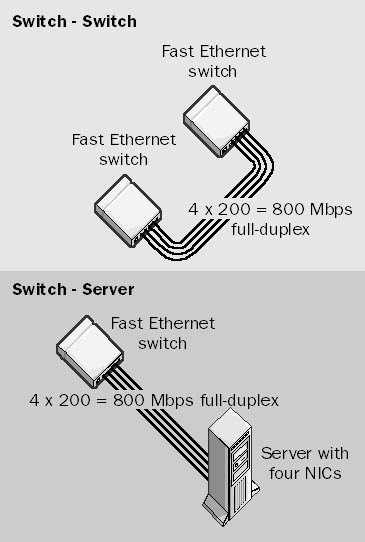Definition of Trunking in the Network Encyclopedia.
What is Trunking (in computer networking)?
Trunking, in switched ethernet networking, is any method of aggregating the physical network links into a single logical link.

Trunking provides a way of overcoming the bandwidth limitations of a single physical link and is used in both switch-to-switch and switch-to-server connections to relieve traffic congestion.
A number of vendors have implemented trunking hardware and/or software, and a standard called IEEE 802.3ad that ensures interoperability among the different vendor offerings should be approved soon.
How It Works
Trunking is essentially a form of inverse multiplexing and is often used to aggregate multiple wide area network (WAN) connections into a single connection. In the switched local area network (LAN) environment, trunking was originally used to reduce congestion in switch-to-switch connections. By aggregating several 100-Mbps links between Fast Ethernet switches, you can achieve data rates of 300 or 400 Mbps between the switches to accommodate network backbone traffic. In a full-duplex configuration, this means rates of 600 or 800 Mbps, which rivals the more expensive Gigabit Ethernet technology and gives new life to old switches.
You can also implement trunking in switch-to-server connections so that multiple connections to a single server can be aggregated. This form of trunking can be purely software based or can be implemented as a combination of both hardware and software. For example, trunking software installed on multiple network interface cards (NICs) in the server automatically handles load balancing across the various server interfaces and can remove an interface from the trunking group if the interface goes down. This provides increased bandwidth between the server and the switch and ensures fault-tolerant operation.

Trunking comes in two varieties:
- Symmetrical trunking: Allows any port in a trunking group to transmit packets to any other port. Full-duplex connections are thus supported over all links in the group. For example, a server can both transmit and receive data at 400 Mbps in a trunked group of four interfaces and one switch.
- Asymmetrical trunking: Allows any port in a trunking group to transmit packets but allows only one port (the port on the switch) to receive packets. The server can transmit data at 400 Mbps but can receive data at only 100 Mbps.
Trunking multiple switches
Trunking by itself is limited to point-to-point connections between two switches or between a switch and a server. However, you can use the Multipoint Link Aggregation (MPLA) technology developed by 3Com to aggregate physical links connected to different switches into a single logical link. MPLA thus supports multipath trunking between multiple switches and servers, giving network administrators flexibility in configuring their hardware for optimal traffic servicing. Other vendors are working on similar multipath trunking technologies, but no standards have emerged yet.
Although the theoretical speed for quadruple-trunked full-duplex Fast Ethernet connections is 800 Mbps, in practice the maximum achievable rate is about 560 Mbps because of traffic overhead.
Software-based trunking
Software-based trunking adds overhead of up to 5 percent to the server’s CPU, depending on the software and the NIC used. Look for special NICs from trunking software vendors with on-board processors that can run the trunking software and thus reduce the load on the CPU. Also, don’t mix and match trunking software or hardware from different vendors in a single trunking group.
Switches must be intelligent if they are to properly support trunked connections. Check your switch documentation before you attempt to implement trunking on your network.
Not only is it often more economical to trunk Fast Ethernet lines than to upgrade to Gigabit Ethernet, but trunked Fast Ethernet cable runs can go farther than Gigabit Ethernet cable runs can. However, in certain situations, trunking does not improve things. For example, trunking cannot speed up server-to-server backups.